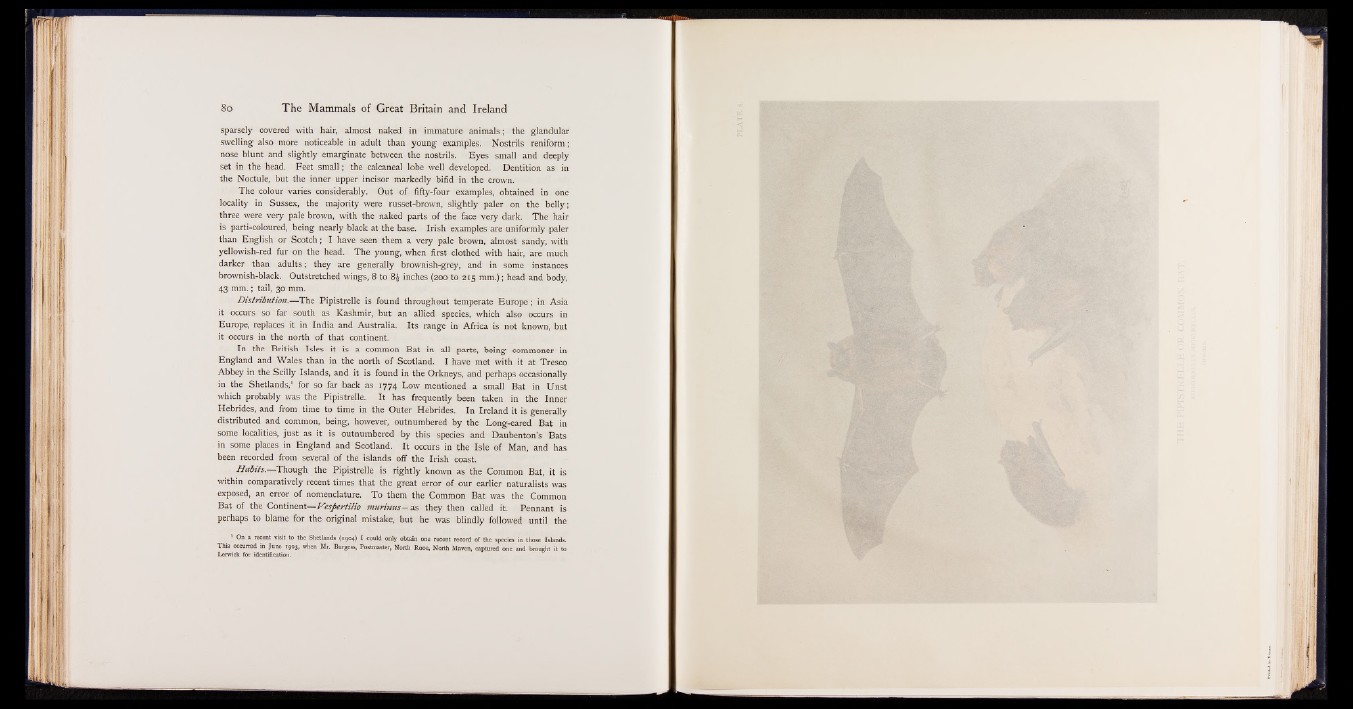
sparsely covered with hair, almost naked in immature animals; the glandular
swelling also more noticeable in adult than young examples. Nostrils reniform;
nose blunt and slightly emarginate between the nostrils. Eyes small and deeply
set in the head. Feet small; the calcaneal lobe well developed. Dentition as in
the Noctule, but the inner upper incisor markedly bifid in the crown.
The colour varies considerably. Out of fifty-four examples, obtained in one
locality in Sussex, the majority were russet-brown, slightly paler on the belly;
three were very pale brown, with the naked parts of the face very dark. The hair
is parti-coloured, being nearly black at the base. Irish examples are uniformly paler
than English or Scotch; I have seen them a very pale brown, almost sandy, with
yellowish-red fur on the head. The young, when first clothed with hair, are much
darker than adults; they are generally brownish-grey, and in some instances
brownish-black. Outstretched wings, 8 to 8£ inches (200 to 215 mm.); head and body,
43 mm.; tail, 30 mm.
Distribution.— The Pipistrelle is found throughout temperate Europe; in Asia
it occurs so far south as Kashmir, but an allied species, which also occurs in
Europe, replaces it in India and Australia. Its range in Africa is not known, but
it occurs in the north of that continent.
In the British Isles it is a common Bat in all parts, being commoner in
England and Wales than in the north of Scotland. I have met with it at Tresco
Abbey in the Scilly Islands, and it is found in the Orkneys, and perhaps occasionally
in the Shetlands,1 for so far back as 1774 Low mentioned a small Bat in Unst
which probably was the Pipistrelle. It has frequently been taken in the Inner
Hebrides, and from time to time in the Outer Hebrides. In Ireland it is generally
distributed and common, being, however, outnumbered by the Long-eared Bat in
some localities, just as it is outnumbered by this species and Daubenton’s Bats
in some places in England and Scotland. It occurs in the Isle of Man, and has
been recorded from several of the islands off the Irish coast.
Habits.—Though the Pipistrelle is rightly known as the Common Bat, it is
within comparatively recent times that the great error of our earlier naturalists was
exposed, an error of nomenclature. To them the Common Bat was the Common
Bat of the Continent— Vespertilio murinus— as they then called it. Pennant is
perhaps to blame for the original mistake, but he was blindly followed until the
1 On a recent visit to the Shetlands (1904) I could only obtain one recent record of the species in those Islands.
This occurred in June 1903, when Mr. Burgess, Postmaster, North Rooe, North Maven, captured one and brought it to
Lerwick for identification.